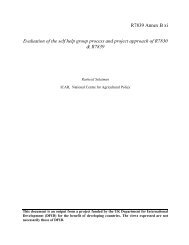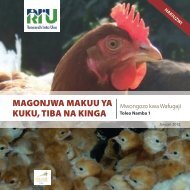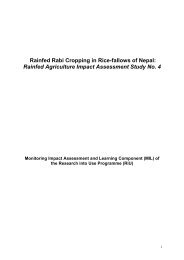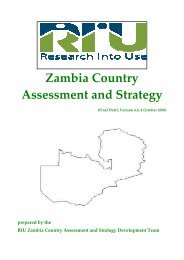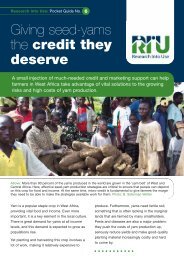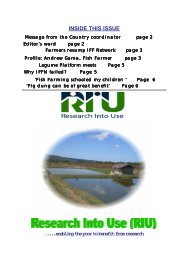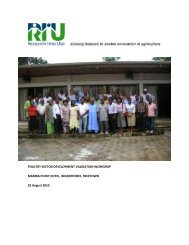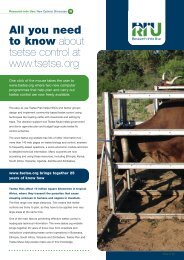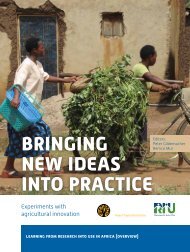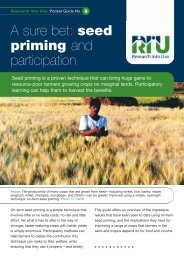2 Combating damaging parasites in goats and sheep RIU Pocket ...
2 Combating damaging parasites in goats and sheep RIU Pocket ...
2 Combating damaging parasites in goats and sheep RIU Pocket ...
Create successful ePaper yourself
Turn your PDF publications into a flip-book with our unique Google optimized e-Paper software.
animals are not receiv<strong>in</strong>g a sufficiently nutritiousdiet <strong>and</strong> can also help to s<strong>in</strong>gle out animals thatare genetically susceptible to <strong>parasites</strong>. Farmerscan then select <strong>and</strong> breed from stronger, moreresistant animals.Controll<strong>in</strong>g stomach nematodes before animalsget sick also allows farmers to help livestock togrow faster <strong>and</strong> bigger. This means that femalescan breed more efficiently, <strong>and</strong> that males can besold sooner. It also makes animals simpler tomanage, as it is generally easier to care foranimals that are healthy.Controll<strong>in</strong>g stomachnematodes beforeanimals get sick alsoallows farmers to helplivestock to grow faster<strong>and</strong> biggerSimple, cheap IgA tests are currently be<strong>in</strong>gdeveloped for use by farmers—so look out forthese <strong>in</strong> the future.Recognis<strong>in</strong>g the signs of parasite<strong>in</strong>ducedanaemiaAnaemia is a sign of parasitism. Scientists havedeveloped a system known as FAMACHA © thathelps livestock keepers to discover whether ananimal is anaemic—<strong>and</strong> to what degree—bycompar<strong>in</strong>g the colour of the mucous membranesof its eyes with colours on a specially preparedset of cards. In this way, farmers can identifyanimals suffer<strong>in</strong>g from nematode <strong>in</strong>fection <strong>and</strong>target them for treatment.Above & below left: TheFAMACHA © system provides asimple, h<strong>and</strong>s-on means ofdetect<strong>in</strong>g parasite-<strong>in</strong>ducedanaemia <strong>in</strong> <strong>goats</strong> <strong>and</strong> <strong>sheep</strong>.It <strong>in</strong>volves compar<strong>in</strong>g thecolour of the p<strong>in</strong>k mucousmembrane around the eyewith a colour chart.Photos: K. Campbell3
Research <strong>in</strong>to Use: <strong>Pocket</strong> Guide No. 26How to make low-cost UMB cont.How UMB work1. Weigh 3.9 kg of molasses <strong>and</strong> place it <strong>in</strong> alarge bowl.2. Add 500 g of common salt <strong>and</strong> 1 kg of urea<strong>and</strong> mix well by h<strong>and</strong>.3. Store this mixture overnight or for at least12 hours.4. Thoroughly mix the contents of the bowl byh<strong>and</strong> once more.5. Add the wheat bran, rice polish<strong>in</strong>gs (husks),<strong>and</strong> lime (which were previously kept <strong>in</strong>separate bowls) <strong>and</strong> mix well by h<strong>and</strong>.6. Fill a 9-<strong>in</strong>ch long, 5-<strong>in</strong>ch wide <strong>and</strong> 5-<strong>in</strong>ch high(or similar sized) conta<strong>in</strong>er with the mixture<strong>and</strong> apply pressure to shape the block. (Ablock prepared <strong>in</strong> this way usually weighs 2.5kg. The mixture can also be pressed <strong>in</strong> thebowl <strong>in</strong> which it was prepared. Remember touse a strong conta<strong>in</strong>er.)7. Remove the block from the conta<strong>in</strong>er <strong>and</strong> letit harden for 15 hours, after which it will beready for consumption by the animals.Animals should consume the UMB by lick<strong>in</strong>g.Care should be taken to ensure that they cannotbite the blocks (for <strong>in</strong>stance, the blocks can beplaced <strong>in</strong> a metal "cage"). If necessary, theanimals can be encouraged to lick the block byspread<strong>in</strong>g salt or bran on it.Molasses provides a fermentable substrate aswell as m<strong>in</strong>erals (calcium) <strong>and</strong> trace elements. Itspleasant taste <strong>and</strong> smell makes urea–molassesblocks attractive to animals. Molasses also helpsto solidify the blocks.Urea provides fermentable nitrogen, the mostimportant component of the block. Nitrogenmakes forage easier to digest <strong>and</strong> compensatesfor the loss of prote<strong>in</strong> through parasitism. It doesso by promot<strong>in</strong>g microbial fermentation of theforage, which <strong>in</strong> turn leads to <strong>in</strong>creasedavailability of prote<strong>in</strong> after rum<strong>in</strong>ation.Wheat or rice bran provides key nutrients (e.g.fat, prote<strong>in</strong>, <strong>and</strong> phosphorus), soaks up moisture,<strong>and</strong> helps solidify the blocks. It may be replacedby other fibrous materials (e.g., dry <strong>and</strong> f<strong>in</strong>elycrushed sugar cane or groundnut hulls).A gell<strong>in</strong>g agent, or b<strong>in</strong>der, is needed to solidifythe blocks. Several products can be used,<strong>in</strong>clud<strong>in</strong>g magnesium oxide, bentonite, calciumoxide (lime), <strong>and</strong> calcium hydroxide.Crop residues <strong>and</strong> by-products can be<strong>in</strong>cluded to provide additional nutrients, accord<strong>in</strong>gto their availability.M<strong>in</strong>erals may be added if available. Salt, whichis <strong>in</strong>expensive, is generally added becauseanimals often do not get enough <strong>in</strong> their diets.Above: Nutritious urea-molasses feedblocks arecheap <strong>and</strong> easy to make. Used as a supplement,they help animals fight <strong>parasites</strong>.Photo: S. Khan/S. SiddikiChemicals or drugs may be added to control<strong>parasites</strong> or to manipulate the fermentation offood <strong>in</strong> animals' rumens.
Tools, guidel<strong>in</strong>es <strong>and</strong> contactIf you want to f<strong>in</strong>d out more, here are some tools<strong>and</strong> guidel<strong>in</strong>es that may be helpful.1. The FAMACHA © system2. Goatkeepers' Animal Health Care Manual3. Worms <strong>in</strong> your Goats, Sheep <strong>and</strong> Cattle4. Smallstock Toolbox5. Tann<strong>in</strong>s <strong>and</strong> WormsContactFor more <strong>in</strong>formation on the tools <strong>and</strong> guidel<strong>in</strong>esabove, please contact Dr Wyn Richards(w.richards@nr<strong>in</strong>t.co.uk), at the Research <strong>in</strong>toUse Programme, NR International, Park House,Bradbourne Lane, Aylesford, KentME20 6SN, UK.Also see the websites www.lpp.uk.com <strong>and</strong>www.dfid-ahp.org.ukAbout this seriesResearch <strong>in</strong>to Use <strong>Pocket</strong> Guides showcase newtechnologies that have been tried <strong>and</strong> tested, <strong>and</strong>have proven successful <strong>in</strong> the field. They wereproduced to demonstrate the importance of highqualityscientific communication.This <strong>Pocket</strong> Guide was developed from researchfunded by the UK Department for InternationalDevelopment (DFID), Animal Health Programme(Project R8151). The views expressed are notnecessarily those of DFID.<strong>RIU</strong> is managed by Natural ResourcesInternational Ltd., <strong>in</strong> partnership with NkoolaInstitutional Development Associates Ltd. (NIDA)<strong>and</strong> Michael Fl<strong>in</strong>t <strong>and</strong> Performance AssessmentResource Centre. <strong>RIU</strong> is funded by DFID.www.research<strong>in</strong>touse.comThe <strong>Pocket</strong> Guide series was developed, written, designed <strong>and</strong>pr<strong>in</strong>ted for <strong>RIU</strong> by SCRIPTORIA (www.scriptoria.co.uk)



